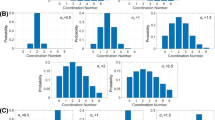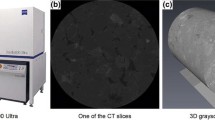Abstract
Transport of small hydrocarbon molecules inside organic nanopores is of great interest in the oil and gas production from source rocks such as shale. Because of the small pore sizes, it is difficult to measure transport directly in the laboratory but require alternative approaches such as molecular simulation. Existing molecular models use nanoscale capillaries and do not describe the exact geometric structure of the organic nanopores in real source rocks, especially for mesopores (2–50 nm in diameter, defined by IUPAC), which widely exist in organic solids and are crucial for fluid transport in the source rocks. Here we present a new method to simplify the existing molecular kerogen models. Pore structures can be built to reflect the exact porous structure of hydrocarbon-bearing kerogen pores for fluid transport without losing accuracy. The kerogen pore-network skeleton can be populated based on 3D digital segments obtained from high-resolution TEM tomographs, combining with other material properties, including the elemental composition and density of the organic solid. The basic idea of the simplified molecular model is to ignore the detailed chemical information of the kerogen molecules and to use a uniform “representative” atom to replace all various atom types, while maintaining the geometric structure intact. To test the transport simulation accuracy using molecular dynamics for this simplified model, sample pore-network structures are populated with both the existing exact molecular model and the simplified model, and the permeability of reservoir fluid flowing through the media is simulated and compared. Specifically, simple reservoir fluids are charged into the space of the 3D porous networks with grand canonical Monte Carlo simulation at given subsurface condition; then, the fluids are driven by an external force field to flow through the network using non-equilibrium molecular dynamics simulation. The simplified kerogen model can be easily applied to larger organic porous material samples to reduce spatial uncertainty, provided enough computational resources.















Similar content being viewed by others
Abbreviations
- D :
-
Diffusivity
- k :
-
Permeability
- µ :
-
Permeability
- ΔP :
-
Pressure drop
- ΔX :
-
Length of sample
- Δc :
-
Concentration drop
- \( \overline{v}_{x} \) :
-
Average Darcy velocity
- J :
-
Flux
- c :
-
Concentration
- V, E :
-
Potential energy
- m :
-
Atomic mass
- n :
-
Number of atoms
- q :
-
Atomic charge
References
Adesida, A., Akkutlu, I., Resasco, D., Rai, C.: Kerogen pore size distribution of Barnett shale using DFT analysis and Monte Carlo simulations. Paper SPE 147397 presented during the SPE annual technical conference and exhibition held in Denver, Colorado, 30 October–2 November (2011). doi: http://dx.doi.org/10.2118/147397-MS
Ambrose, R.J., Hartman, R.C., Diaz Campos, M., Akkutlu, I.Y., Sondergeld, C.: New pore-scale considerations for shale gas in place calculations. Paper presented at the SPE Unconventional Gas Conference (2010)
Andra, H., Combaret, N., Dvorkin, J., Glatt, E., Han, J., Kabel, M., Keehm, Y., Krzikalla, F., Lee, M., Madonna, C., Marsh, M., Mukerji, T., Saenger, E.H., Sain, R., Saxena, N., Ricker, S., Wiegmann, A., Zhan, X.: Digital rock physics benchmarks-Part I: imaging and segmentation. Comput. Geosci. 50, 25–32 (2013a). https://doi.org/10.1016/j.cageo.2012.09.005
Andra, H., Combaret, N., Dvorkin, J., Glatt, E., Han, J., Kabel, M., Keehm, Y., Krzikalla, F., Lee, M., Madonna, C., Marsh, M., Mukerji, T., Saenger, E.H., Sain, R., Saxena, N., Ricker, S., Wiegmann, A., Zhan, X.: Digital rock physics benchmarks-part II: computing effective properties. Comput. Geosci. 50, 33–43 (2013b). https://doi.org/10.1016/j.cageo.2012.09.008
Arya, G., Chang, H.C., Maginn, E.J.: A critical comparison of equilibrium, non-equilibrium and boundary-driven molecular dynamics techniques for studying transport in microporous materials. J. Chem. Phys. 115(17), 8112–8124 (2001). https://doi.org/10.1063/1.1407002
Bhattacharya, S., Gubbins, K.E.: Fast method for computing pore size distributions of model materials. Langmuir 22(18), 7726–7731 (2006). https://doi.org/10.1021/la052651k
Bousige, C., Botan, A., Ulm, F.J., Pellenq, R.J.M., Coasne, B.: Optimized molecular reconstruction procedure combining hybrid reverse Monte Carlo and molecular dynamics. J. Chem. Phys. (2015). https://doi.org/10.1063/1.4914921
Bousige, C., Ghimbeu, C.M., Vix-Guterl, C., Pomerantz, A.E., Suleimenova, A., Vaughan, G., Garbarino, G., Feygenson, M., Wildgruber, C., Ulm, F.J., Pellenq, R.J.M., Coasne, B.: Realistic molecular model of kerogen’s nanostructure. Nat. Mater. 15(5), 576 (2016). https://doi.org/10.1038/nmat4541
Collell, J., Ungerer, P., Galliero, G., Yiannourakou, M., Montel, F., Pujol, M.: Molecular simulation of bulk organic matter in type II shales in the middle of the oil formation window. Energy Fuels 28(12), 7457–7466 (2014). https://doi.org/10.1021/ef5021632
Collell, J., Galliero, G., Vermorel, R., Ungerer, P., Yiannourakou, M., Montel, F., Pujol, M.: Transport of multicomponent hydrocarbon mixtures in shale organic matter by molecular simulations. J. Phys. Chem. C 119(39), 22587–22595 (2015). https://doi.org/10.1021/acs.jpcc.5b07242
Dauberosguthorpe, P., Roberts, V.A., Osguthorpe, D.J., Wolff, J., Genest, M., Hagler, A.T.: Structure and energetics of ligand-binding to proteins—Escherichia coli dihydrofolate reductase trimethoprim, a drug-receptor system. Proteins Struct. Funct. Genet. 4(1), 31–47 (1988). https://doi.org/10.1002/prot.340040106
Evans, D.J., Morriss, G.P.: Isothermal isobaric molecular-dynamics. Chem. Phys. 77(1), 63–66 (1983). https://doi.org/10.1016/0301-0104(83)85065-4
Falk, K., Coasne, B., Pellenq, R., Ulm, F.J., Bocquet, L.: Subcontinuum mass transport of condensed hydrocarbons in nanoporous media. Nat. Commun. (2015a). https://doi.org/10.1038/ncomms7949
Falk, K., Pellenq, R., Ulm, F.J., Coasne, B.: Effect of chain length and pore accessibility on alkane adsorption in kerogen. Energy Fuels 29(12), 7889–7896 (2015b). https://doi.org/10.1021/acs.energyfuels.5b02015
Fathi, E., Akkutlu, I.Y.: Lattice Boltzmann method for simulation of shale gas transport in kerogen. Spe J. 18(1), 27–37 (2013)
Feng, F., Akkutlu, I.Y.: Flow of hydrocarbons in nanocapillary: A non-equilibrium molecular dynamics study. Paper presented at the SPE Asia Pacific Unconventional Resources Conference and Exhibition (2015)
Firouzi, M., Wilcox, J.: Molecular modeling of carbon dioxide transport and storage in porous carbon-based materials. Microporous Mesoporous Mater. 158, 195–203 (2012). https://doi.org/10.1016/j.micromeso.2012.02.045
Hahn, K., Karger, J., Kukla, V.: Single-file diffusion observation. Phys. Rev. Lett. 76(15), 2762–2765 (1996). https://doi.org/10.1103/PhysRevLett.76.2762
Hanasaki, I., Nakatani, A.: Flow structure of water in carbon nanotubes: Poiseuille type or plug-like? J. Chem. Phys. 124(14), 144708 (2006). https://doi.org/10.1063/1.2187971
Ho, T.A., Criscenti, L.J., Wang, Y.F.: Nanostructural control of methane release in kerogen and its implications to wellbore production decline. Sci. Rep. (2016). https://doi.org/10.1038/srep28053
Hu, Y.L., Zhang, Q., Li, M.R., Pan, X.L., Fang, B., Zhuang, W., Han, X.W., Bao, X.H.: Facilitated diffusion of methane in pores with a higher aromaticity. J. Phys. Chem. C 120(35), 19885–19889 (2016). https://doi.org/10.1021/acs.jpcc.6b07500
Kou, R., Alafnan, S.F.K., Akkutlu, I.Y.: Multi-scale analysis of gas transport mechanisms in kerogen. Transp. Porous Media 116(2), 493–519 (2017). https://doi.org/10.1007/s11242-016-0787-7
Lee, T., Bocquet, L., Coasne, B.: Activated desorption at heterogeneous interfaces and long-time kinetics of hydrocarbon recovery from nanoporous media. Nat. Commun. (2016). https://doi.org/10.1038/ncomms11890
Makrodimitris, K., Papadopoulos, G.K., Theodorou, D.N.: Prediction of permeation properties of CO2 and N2 through silicalite via molecular simulations. J. Phys. Chem. B 105(4), 777–788 (2001). https://doi.org/10.1021/jp002866x
Martin, M.G., Siepmann, J.I.: Transferable potentials for phase equilibria. 1. United-atom description of n-alkanes. J. Phys. Chem. B 102(14), 2569–2577 (1998). https://doi.org/10.1021/jp972543+
Martin, M.G., Siepmann, J.I.: Novel configurational-bias Monte Carlo method for branched molecules. Transferable potentials for phase equilibria. 2. United-atom description of branched alkanes. J. Phys. Chem. B 103(21), 4508–4517 (1999). https://doi.org/10.1021/jp984742e
Milliken, K.L., Curtis, M.E.: Imaging pores in sedimentary rocks: foundation of porosity prediction. Mar. Pet. Geol. 73, 590–608 (2016). https://doi.org/10.1016/j.marpetgeo.2016.03.020
Mutat, T., Adler, J., Sheintuch, M.: Single species transport and self diffusion in wide single-walled carbon nanotubes. J. Chem. Phys. (2012). https://doi.org/10.1063/1.4727759
Riewchotisakul, S., Akkutlu, I.Y.:( Molecular transport of simple gases in carbon nanotubes under high pressure and temperature using NEMD. Submitted to AICHE Journal (2014)
Sun, H.: (PCFF) Ab-initio calculations and force-field development for computer-simulation of polysilanes. Macromolecules 28(3), 701–712 (1995). https://doi.org/10.1021/ma00107a006
Sun, H.: COMPASS: an ab initio force-field optimized for condensed-phase applications—overview with details on alkane and benzene compounds. J. Phys. Chem. B 102(38), 7338–7364 (1998). https://doi.org/10.1021/jp980939v
Sun, H., Mumby, S.J., Maple, J.R., Hagler, A.T.: PCFF: an ab initio Cff93 all-atom force-field for polycarbonates. J. Am. Chem. Soc. 116(7), 2978–2987 (1994). https://doi.org/10.1021/ja00086a030
Ungerer, P., Collell, J., Yiannourakou, M.: Molecular modeling of the volumetric and thermodynamic properties of kerogen: influence of organic type and maturity. Energy Fuels 29(1), 91–105 (2015). https://doi.org/10.1021/ef502154k
Vandenbroucke, M.: Kerogen: from types to models of chemical structure. Oil Gas Sci. Technol. Rev. D Ifp Energies Nouvelles 58(2), 243–269 (2003). https://doi.org/10.2516/ogst:2003016
Zhou, B., Xu, R.N., Jiang, P.X.: Novel molecular simulation process design of adsorption in realistic shale kerogen spherical pores. Fuel 180, 718–726 (2016). https://doi.org/10.1016/j.fuel.2016.04.096
Acknowledgements
This material is based upon work supported by the Crisman Institute for Petroleum Research and Berg-Hughes Center of Texas A&M University, with the help from High Performance Research Computing of Texas A&M University for numerical simulation work.
Author information
Authors and Affiliations
Corresponding author
Appendix
Appendix
1.1 Force Field Parameters
In the flow simulation, OPLS-AA force field is used to describe fluid molecules, with bond, angles, dihedrals described in the equation forms below (Tables 2 and 3).
1.2 Basic Information of Kerogen Building Blocks
See Table 4.
1.3 Supplementary Interaction Terms for PCFF, CVFF Force Fields
To validate the simplified molecular model, CVFF and PCFF shall include more interactions to better describe the exact kerogen molecule building block. For CVFF force field, the equivalency table is slightly expanded to accommodate more interaction types; both CVFF and PCFF have included additional bond and angle coefficients based on similar bonds and angles. For dihedrals and improper dihedrals, which are not included in CVFF and PCFF, they are not taken into consideration. These parameters are listed in Tables 5, 6, 7, 8, and 9.
Rights and permissions
About this article
Cite this article
Feng, F., Akkutlu, I.Y. A Simple Molecular Kerogen Pore-Network Model for Transport Simulation in Condensed Phase Digital Source-Rock Physics. Transp Porous Med 126, 295–315 (2019). https://doi.org/10.1007/s11242-018-1149-4
Received:
Accepted:
Published:
Issue Date:
DOI: https://doi.org/10.1007/s11242-018-1149-4




